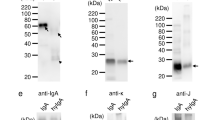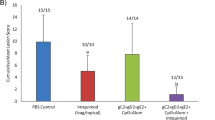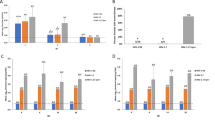Abstract
The ability to produce monoclonal antibodies (Mabs) in plants offers the opportunity for the development of an inexpensive method of mucosal immunoprotection against sexually transmitted diseases. To investigate the suitability of plant-expressed Mabs for vaginal preventive applications, we compared a humanized anti–herpes simplex virus 2 (HSV-2) Mab expressed in mammalian cell culture with the same antibody expressed in soybean. We found these Mabs to be similar in their stability in human semen and cervical mucus over 24 h, their ability to diffuse in human cervical mucus, and their efficacy for prevention of vaginal HSV-2 infection in the mouse.
This is a preview of subscription content, access via your institution
Access options
Subscribe to this journal
Receive 12 print issues and online access
$209.00 per year
only $17.42 per issue
Buy this article
- Purchase on Springer Link
- Instant access to full article PDF
Prices may be subject to local taxes which are calculated during checkout




Similar content being viewed by others
References
Eng, T. and Butler, W. 1997. The hidden epidemic. National Academy Press, Washington, D.C.
Cone, R.A. and Whaley, K.J. 1994. Monoclonal antibodies for reproductive health: part I. Preventing sexual transmission of disease and pregnancy with topically applied antibodies. Am. J. Reprod. Immunol. 32: 114–131.
Davidson, G.P., Whyte, P.B., Daniels, E., Franklin, K., Nunan, H., McCloud, P.I. et al. 1989. Passive immunisation of children with bovine colostrum containing antibodies to human rotavirus. Lancet 2: 709– 712.
Tamura, S., Funato, H., Hirabayashi, Y., Suzuki, Y., Nagamine, T., Aizawa, C. et al. 1991. Cross-protection against influenza A virus infection by passively transferred respiratory tract IgA antibodies to different hemagglutinin molecules. Eur. J. Immunol. 21: 1337–1344.
Whaley, K.J., Zeitlin, L., Barratt, R.A., Hoen, T.E., and Cone, R.A. 1994. Passive immunization of the vagina protects mice against vaginal transmission of genital herpes infections. J. Infect. Dis. 169: 647 –649.
Zeitlin, L., Whaley, K.J., Sanna, P.P., Moench, T.R., Bastidas, R., De Logu, A. et al 1996. Topically applied human recombinant monoclonal IgG1 antibody and its Fab and F(ab')2 fragments protect mice from vaginal transmission of HSV-2. Virology 225: 213–215.
Zeitlin, L., Doctoral dissertation, Topical methods for preventing genital herpes infection in the mouse. The Johns Hopkins University, Baltimore, MD, 1996.
Co, M.S. and Queen, C. 1991. Humanized antibodies for therapy. Nature 351: 501– 502.
Burton, D. and Barbas, C. 1994. Human antibodies from combinatorial libraries. Adv. Immunol. 57: 191–280.
Winter, G., Griffiths, A., Hawkins, R., and Hoogenboom, H. 1994. Making antibodies by phage display technology. Annu. Rev. Immunol. 12: 433– 455.
Williamson, R., Burioni, R., Sanna, P., Partridge, L., Barbas, C., and Burton, D. 1993. Human monoclonal antibodies against a plethora of viral pathogens from single combinatorial libraries. Proc. Natl. Acad. Sci. USA 90: 4141–4145.
Hiatt, A., Caffertey, R., and Bowdish, K. 1989. Production of antibodies in transgenic plants. Nature 342: 76– 78.
Ma, J., Hiatt, A., Hein, M., Vine, N., Wang, F., Stabila, P. et al. 1995. Generation and assembly of secretory antibodies in plants. Science 268: 716–719.
Hiatt, A. 1990. Antibodies produced in plants. Nature 344: 469–470.
Wright, A. and Morrison, S. 1997. Effect of glycosylation on antibody function: implications for genetic engineering. Trends Biotechnol. 15: 26– 32.
Co, M.S., Deschamps, M., Whitley, R.J., and Queen, C. 1991. Humanized antibodies for antiviral therapy. Proc. Natl. Acad. Sci. USA 88: 2869–2873.
Fleming, D., McQuillian, G., Johnson, R., Nahmias, A., Aral, S., Lee, F. et al. 1997. Herpes simplex virus type 2 in the United States, 1976 to 1994. N. Engl. J. Med. 337: 1105–1111.
Hook, E.W., Cannon, R.O., Nahmias, A.J., Lee, F.F., Campbell, C.H., Glasser, D. et al. 1992. Herpes simplex virus infection as a risk factor for human immunodeficiency virus infection in heterosexuals. J. Infect. Dis. 165: 251– 255.
Gwanzura, L., McFarland, W., Alexander, D., Burke, R.L., and Katzenstein, D. 1998. Association between human immunodeficiency virus and herpes simplex virus type 2 seropositivity among male factory workers in Zimbabwe. J. Infect. Dis. 177: 481–484.
Saltzman, W.M., Radomsky, M.L., Whaley, K.J., and Cone, R.A. 1994. Antibody diffusion in human cervical mucus. Biophys. J. 66: 508–515.
Cone, R. 1999. Mucus, pp. 43–64 in Handbook of mucosal immunology, 2nd ed. Ogra, P.L., Mestecky, J., Lamm, M.E., Strober, W., McGhee, J.R., Bienenstock, J. (eds.). Academic Press, Washington, D.C. In press.
Whaley, K.J., Barratt, R.A., Zeitlin, L., Hoen, T.E., and Cone, R.A. 1993. Nonoxynol-9 protects mice against vaginal transmission of genital herpes infections. J. Infect. Dis. 168: 1009–1011.
Cai, W., Gu, B., and Person, S. 1988. Role of glycoprotein B of herpes simplex virus type 1 in viral entry and cell fusion. J. Virol. 62: 2596–2604.
Hiatt, A. and Ma, J.-C. 1992. Monoclonal antibody engineering in plants. FEBS Lett. 307: 71–75.
Fiedler, U. and Conrad, U. 1995. High-level production and long-term storage of engineered antibodies in transgenic tobacco seeds. Bio/Technology 13: 1090– 1093.
Hiatt, A. and Ma, J.-C. 1993. Characterization and applications of antibodies produced in plants. Int. Rev. Immunol. 10: 139–152.
Friberg, J. 1974. Sperm-agglutinating antibodies and immunoglobulins G and A in stored human seminal fluid. Acta Obstet. Gyn. Scand. Suppl. 36: 59–63.
Tjokronegoro, A. and Sirisinha, S. 1974 . Degradation of immunoglobulins by secretions of human reproductive tracts. J. Reprod. Fertil. 38: 221– 224.
Castle, P. 1995. Contraceptive effect of sperm-agglutinating monoclonal antibodies in rabbit. (Doctoral dissertation). Johns Hopkins University, Baltimore, MD.
Zeitlin, L., Whaley, K.J., Hegarty, T., Moench, T.R., and Cone, R.A. 1997. Tests of vaginal microbicides in the mouse genital herpes model. Contraception 56: 329–335.
Elias, C. and Heise, L. 1994. Challenges for the development of female-controlled vaginal microbicides. AIDS 8: 1–9.
Stone, A. and Hitchcock, P. 1994. Vaginal microbicides for preventing the sexual transmission of AIDS. AIDS (suppl 1) 8: S285–S293.
Stein, Z. 1990. HIV prevention: the need for methods women can use. Am. J. Public Health 80: 460–462.
Sherwood, J.K., Zeitlin, L., Chen, X., Whaley, K.J., Cone, R.A., and Saltzman, W.M. 1996 . Residence half-life of IgG administered topically to the mouse vagina. Biol. Reprod. 54: 264– 269.
Sherwood, J.K., Zeitlin, L., Whaley, K.J., Cone, R.A., and Saltzman, W.M. 1996. Controlled release of antibodies for long-term topical passive immunoprotection of female mice against genital herpes. Nat. Biotechnol. 14: 468–471.
Radomsky, M.L., Whaley, K.J., Cone, R.A., and Saltzman, W.M. 1992 . Controlled vaginal delivery of antibodies in the mouse. Biol. Reprod. 47: 133–140.
Ma, J.K. and Hein, M.B. 1995. Immunotherapeutic potential of antibodies produced in plants. Trends Biotechnol. 13: 522–527.
Miele, L. 1997. Plants as bioreactors for biopharmaceuticals: regulatory considerations. Trends Biotechnol. 15: 45– 50.
Ma, J. K-C., Hikmat, B.Y., Wycoff, K., Vine, N.D., Chargelegue, D., Yu, L. et al. 1998. Characterization of a recombinant plant monoclonal secretory antibody and preventive immunotherapy in humans. Nat. Med. 4: 601–606.
Sherman-Gold, R. August 1997. Monoclonal antibodies: the evolution from '80s magic bullets to mature, mainstream applications as clinical therapeutics. Genetic Engineering News. August, p. 4.
Wong, J. 1998. Monoclonals to hit stride in '98. Genetic Engineering News. January, p. 21.
Zeitlin, L., Cone, R.A., and Whaley, K.J. Monoclonal antibodies for preventing mucosal transmission of epidemic infectious diseases. Emerg. Infect. Dis. In press.
Francisco, J.A., Gawlak, S.A., Miller, M., Bathe, J., Russell, D., Chance, D. et al. 1997. Expression and characterization of bryodin 1 and a bryodin 1-based single-chain immunotoxin from tobacco cell culture. Bioconjugate Chem. 8: 708–713.
McCabe, D.E., Swain, W.F., Martinell, B.J., and Christou, P. 1988. Stable transformation of soybean (Glycine max) by particle acceleration. Bio/Technology 6: 923–926.
Wolf, D. 1989. Designing, building, and using a fluorescence recovery after photobleaching instrument. pp 271–306 in Fluorescence microscopy of living cells in culture. Part B. Taylor, D. and Wang, Y. (eds.). Academic Press, San Diego, CA.
Barisas, B. and Leuther, M. 1977. Fluorescence photobleaching recovery measurement of protein absolute diffusion constants. Biophys. Chem. 10: 221– 229.
Matthews, D. and Farewell, V. 1985. Using and understanding medical statistics. Karger, Basel, Switzerland.
Author information
Authors and Affiliations
Corresponding author
Rights and permissions
About this article
Cite this article
Zeitlin, L., Olmsted, S., Moench, T. et al. A humanized monoclonal antibody produced in transgenic plants for immunoprotection of the vagina against genital herpes. Nat Biotechnol 16, 1361–1364 (1998). https://doi.org/10.1038/4344
Received:
Accepted:
Issue Date:
DOI: https://doi.org/10.1038/4344
This article is cited by
-
Production of functional recombinant cyclic citrullinated peptide monoclonal antibody in transgenic rice cell suspension culture
Transgenic Research (2019)
-
Production of monoclonal antibodies against 53-kDa protein of Porphyromonas gingivalis in transgenic rice cell suspension culture
Plant Cell, Tissue and Organ Culture (PCTOC) (2016)
-
Transgenic rice endosperm as a bioreactor for molecular pharming
Plant Cell Reports (2014)
-
Production of monoclonal antibody against FimA protein from Porphyromonas gingivalis in rice cell suspension culture
Plant Cell, Tissue and Organ Culture (PCTOC) (2014)



